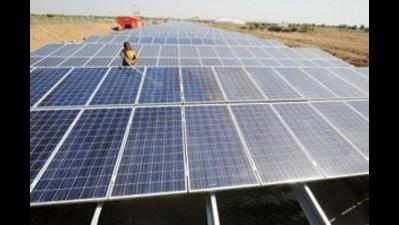- News
- City News
- bhopal News
- Solar lights lead students out of dark in Khandwa
Trending
This story is from September 6, 2016
Solar lights lead students out of dark in Khandwa
They Can Study Twice As Long After Sunset

(Representative image)
BHOPAL: Solar power intervention and promotion in villages of Khandwa region of Madhya Pradesh is not only changing lives by helping cutting down household expenses of residents with savings on fuel bills, but has affected students in these villages the most by helping them increase their study hours.
According to a recent study conducted by a student of Indian Institute of Forest Management, Bhopal and Aga Khan Rural Support Program by Aga Khan Foundation in nine villages of Khandwa region, study hours have increased by 3 to 4 hours with the use of solar lamps.
Rahul Kumar Mehar, student of IIFM Bhopal, who conducted this study said, "Initially we observed students have been studying for maximum an hour or one and half-hour due to lack of electricity, but as soon as they shifted to solar lamps, study hours of study increased gradually in one to two years."
The study was conducted, in 9 villages and 102 households were picked from the population. There were two clusters Khalwa and Balwadi. Khalwa cluster includes 8 villages and 80 households and Balwadi cluster includes only 1 village and 22 households.
The major problems that residents of these villages faced due to other sources of light such as lantern and bottle chimneys were Eye irritation, cough and allergy. "We basically conducted the study on three solar power interventions in these villages that has changed the lives of residents there including solar lamps, solar power grids and solar pumps," said Rahul while talking to TOI.
Of these entire villages model S2 of solar lamps are more in demand due to their multipurpose built, which they are using for irrigation, education and emergency lighting.
The energy initiative by AKRSP (I) implements the programs for India's energy sector and for potential future energy resources available at local level and their benefits. So, it has become inevitable for India to diversify its energy resources. Khandwa region of Madhya Pradesh is one of the worst tribal areas where electricity is out of their reach. AKRSP (I) is working in this tribal areas by distributing solar lamps, Micro grids and establishing solar pumps.
In the off-season solar pumps are used for drawing water for only 15- 20 minutes and in the season of cultivation for 11.29 hours, mainly for irrigation.
Earlier, farmers spent a lot of money - around Rs 1,32,090 - in buying diesel. A diesel pump emits 88.7184 KgC carbon a day, which has now come down, especially in Rojanimal and Maujwadi villages. The experiment, which is repeated 10 times, shows that a pump running at maximum efficiency can pump 200 litres of water in 38.64 seconds.
According to a recent study conducted by a student of Indian Institute of Forest Management, Bhopal and Aga Khan Rural Support Program by Aga Khan Foundation in nine villages of Khandwa region, study hours have increased by 3 to 4 hours with the use of solar lamps.
Rahul Kumar Mehar, student of IIFM Bhopal, who conducted this study said, "Initially we observed students have been studying for maximum an hour or one and half-hour due to lack of electricity, but as soon as they shifted to solar lamps, study hours of study increased gradually in one to two years."
The study was conducted, in 9 villages and 102 households were picked from the population. There were two clusters Khalwa and Balwadi. Khalwa cluster includes 8 villages and 80 households and Balwadi cluster includes only 1 village and 22 households.
Not only the study hours, but total amount of money spent on source of light has also come down, about 80 households on the sources of light spent Rs.72424 in one year on other sources of light. But the total cost of solar lamp distributed in 80 households is approx. Rs.50000 only, added Mehar.
The major problems that residents of these villages faced due to other sources of light such as lantern and bottle chimneys were Eye irritation, cough and allergy. "We basically conducted the study on three solar power interventions in these villages that has changed the lives of residents there including solar lamps, solar power grids and solar pumps," said Rahul while talking to TOI.
Of these entire villages model S2 of solar lamps are more in demand due to their multipurpose built, which they are using for irrigation, education and emergency lighting.
The energy initiative by AKRSP (I) implements the programs for India's energy sector and for potential future energy resources available at local level and their benefits. So, it has become inevitable for India to diversify its energy resources. Khandwa region of Madhya Pradesh is one of the worst tribal areas where electricity is out of their reach. AKRSP (I) is working in this tribal areas by distributing solar lamps, Micro grids and establishing solar pumps.
In the off-season solar pumps are used for drawing water for only 15- 20 minutes and in the season of cultivation for 11.29 hours, mainly for irrigation.
Earlier, farmers spent a lot of money - around Rs 1,32,090 - in buying diesel. A diesel pump emits 88.7184 KgC carbon a day, which has now come down, especially in Rojanimal and Maujwadi villages. The experiment, which is repeated 10 times, shows that a pump running at maximum efficiency can pump 200 litres of water in 38.64 seconds.
End of Article
FOLLOW US ON SOCIAL MEDIA










